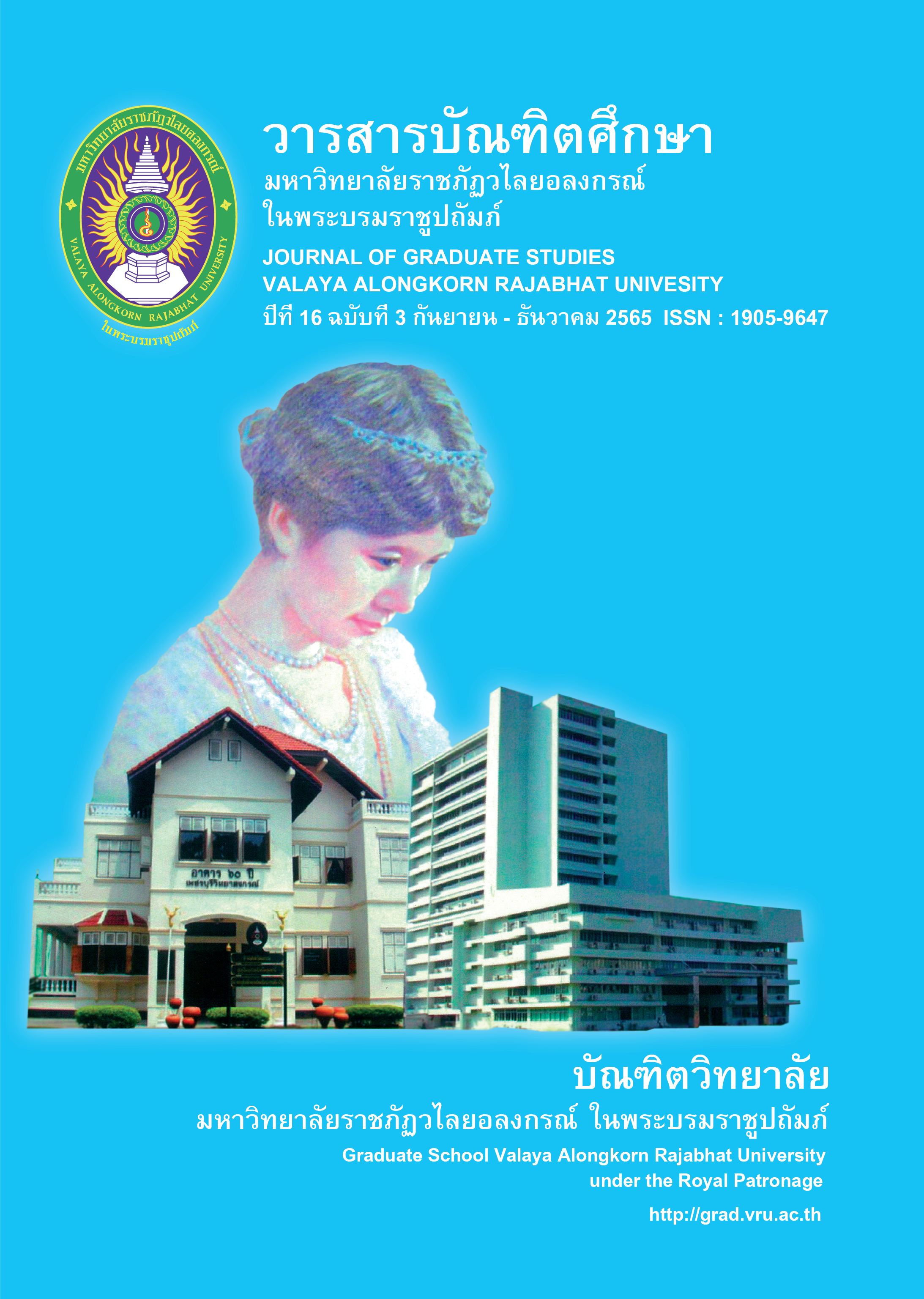APPROACHES TO THE MANAGEMENT OF CULTURE TOURISM IN ACCORDANCE THE IDENTITY OF THE VICINITY CENTRAL PROVINCIAL CLUSTER
Main Article Content
Abstract
The objectives of this research were 1) to evaluate the potentials and to determine the identity of cultural tourism of the Vicinity Central Provincial Cluster, 2) to study the components and cultural tourism management model of the Vicinity Central Provincial Cluster, and 3) to exhibit approaches of cultural tourism management according to the identities of the Vicinity Central Provincial Cluster. The research was qualitative in nature, involving in-depth interviews with 40 individuals from related governmental bodies, private and public sectors. Additionally, an interview session with ten key informants was emphasized. Data analysis by methodical triangulation and SWOT analysis.
The research results were described as follows. The potential and identities of national identity attraction parameters were extremely impressive, while the capacity was adequate in terms of management, the maintenance and rehabilitation of tourist attraction destinations. Personal identities were indicated by central cultural performances in both language and central Thai dress. The Mon culture was also partly found. Social identity was a significant spotlight in Mon culture. The place’s identity was a Thai house with a high basement style along both canals and rivers. 2) The tourist composition parameters have been entirely identified but must be developed. The tourist strategy is excluded due to the lack of clarity in term of tourism strategy
3) Cultural tourism management approaches based on the identities of the Vicinity Central Provincial Cluster via the PDPC model consist of (P: Potential) the potential of cultural tourism, riverside lifestyle, and Mon ethnicity, then (D: Develop) the cultural tourism innovation through digital society and emphasizing the staff skills to support new tourism styles. Next, (P: Promote) was promoted via branding and marketing to suit the digital society. Last (C: Collaboration), the cooperation among tourist industries is supported by network development along the tourism attraction routes with provinces and countries.
Article Details

This work is licensed under a Creative Commons Attribution-NonCommercial-NoDerivatives 4.0 International License.
บทความทุกเรื่องได้รับการตรวจความถูกต้องทางวิชาการโดยผู้ทรงคุณวุฒิ ทรรศนะและข้อคิดเห็นในบทความวารสารบัณฑิตศึกษา มหาวิทยาลัยราชภัฏวไลยอลงกรณ์ ในพระบรมราชูปถัมภ์ มิใช่เป็นทรรศนะและความคิดของผู้จัดทำจึงมิใช่ความรับผิดชอบของบัณฑิตวิทยาลัย มหาวิทยาลัยราชภัฏวไลยอลงกรณ์ ในพระบรมราชูปถัมภ์ กองบรรณาธิการไม่สงวนสิทธิ์การคัดลอก แต่ให้อ้างอิงแหล่งที่มา
References
Department of Tourism Ministry of Tourism and Sports. (2020). sathiti dān kānthō̜ngthīeo [Department of Tourism Ministry of Tourism and Sports]. Retrieved from https://mots.go.th.
Dhamabutra, P. (2019). nǣothāng phatthanā brǣn thō̜ngthīeo chœ̄ng watthanatham 4.0 nai chumchon Bāngkō̜k Yai Krung Thēp Mahā Nakhō̜n [Approaches for cultural tourism 4.0 brand development in Bangkokyai Community, Bangkok]. Sisaket Rajabhat University Journal. 6(1), 83-101.
Fiengfusakul, A. (2017). ʻattalak: kān thopthūan thritsadī læ krō̜p nǣokhit [Identiy]. Bangkok: National Research Council of Thailand (NRCT).
Imiwat, P., Wongpratum, N., Somkuan, K., & Inthep, A. (2019). nawattakam kānčhatkān kānthō̜ngthīeo chœ̄ng prawattisāt læ watthanatham chumchon tām nǣothāng prachā rat nai ʻamphœ̄ Wīang Chai čhangwat Chīang Rāi [The innovation for management of historical and cultural tourism of community under civil state approach in Wiang Chai District, Chiang Rai Province]. The journal of social communication innovation. 7(2), 145-156.
Klinmuenwai, K. (2008). nǣothāng kān songsœ̄m kānthō̜ngthīeo chœ̄ng watthanatham chumchon thā maʻō ʻAmphœ̄ Mư̄ang čhangwat Lampāng [Guidelines for support cultural tourism destination at the ma-o community Mueng Distric, Lampang Province]. Chiang Mai: Maejo University.
Kokkhangplu, A., & Kaewnuch, K. (2017). nǣothāng kānphatthanā prasitthiphāp kān dā nœ̄n ngān lǣng thō̜ngthīeo chumchon khon ʻom čhangwat Nakhō̜n Sī Thammarāt [Guideline to enhance performance efficiency on tourism destination in Khanom Community, Nakhon Si Thammarat Province]. Dusit Thani College Journal. 11(Special Issue), 139-157.
Manirochana, M. (2017). kānčhatkān kānthō̜ngthīeo dōi chumchon [Community based tourism management]. Journal of International and Thai Tourism. 13(2), 25-46.
Tantimala, C. (2017). kānsāng ʻattalak khō̜ng talātnat phāinai mahāwitthayālai khō̜ng rat khēt Krung Thēp Mahā Nakhō̜n [Identity construction of flea markets in public universities in Bangkok]. Bangkok: Srinakharinwirot University.
Techaprasert, K. (2013). phrưttikam kānthō̜ngthīeo khō̜ng klum chāi rak chāi thī ʻāsai nai khēt čhangwat Khō̜n Kǣn [Tourist behaviors of living male homosexual (gay) in khon kaen province]. Khon Kaen: Khon Kaen University.
Timothy, R. (2011). Global livestock production systems. Rome: Food and agriculture organization of the United Nations.
Tongsri, P., & Aman, R. (2021). nǣothāng kānphatthanā krabūankān čhatkān thō̜ngthīeo dōi chumchon ʻāo pāk bā rā ʻamphœ̄ la ngū čhangwat Satūn [The guideline of process development of community-based tourism in Pak Bara Bay Community in La-ngu District, Satun Province]. Journal of Humanities and Social Sciences. 38(1), 107-150.
Wichasawat, W. (2019). nǣothāng kānphatthanā sakkayaphāp kānbō̜rihān læ kānčhatkān kānthō̜ngthīeo dōi chumchon bōrān bān chīang hīan čhangwat Mahā Sārakhām [Guidelines for potential development of administration and management of the Ancient Community at Ban Chianghian, Maha Sarakham Province]. Journal of International and Thai Tourism. 15(2), 21-34.

